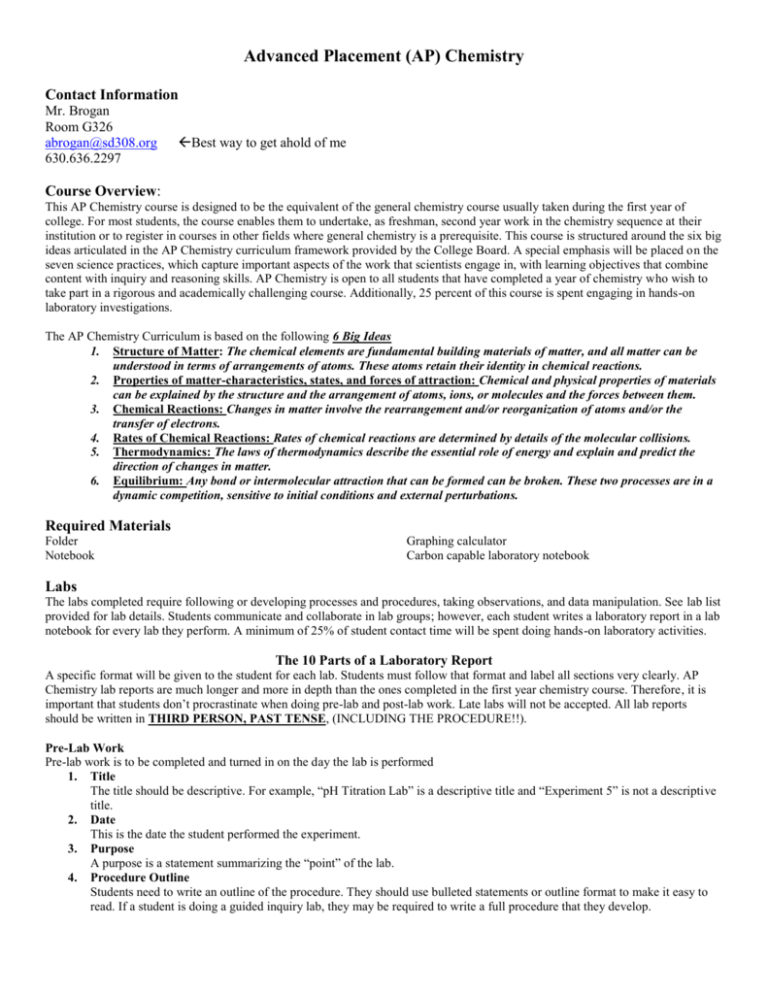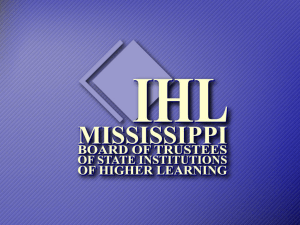Advanced Placement (AP) Chemistry
advertisement

Advanced Placement (AP) Chemistry Contact Information Mr. Brogan Room G326 abrogan@sd308.org 630.636.2297 Best way to get ahold of me Course Overview: This AP Chemistry course is designed to be the equivalent of the general chemistry course usually taken during the first year of college. For most students, the course enables them to undertake, as freshman, second year work in the chemistry sequence at their institution or to register in courses in other fields where general chemistry is a prerequisite. This course is structured around the six big ideas articulated in the AP Chemistry curriculum framework provided by the College Board. A special emphasis will be placed on the seven science practices, which capture important aspects of the work that scientists engage in, with learning objectives that combine content with inquiry and reasoning skills. AP Chemistry is open to all students that have completed a year of chemistry who wish to take part in a rigorous and academically challenging course. Additionally, 25 percent of this course is spent engaging in hands-on laboratory investigations. The AP Chemistry Curriculum is based on the following 6 Big Ideas 1. Structure of Matter: The chemical elements are fundamental building materials of matter, and all matter can be understood in terms of arrangements of atoms. These atoms retain their identity in chemical reactions. 2. Properties of matter-characteristics, states, and forces of attraction: Chemical and physical properties of materials can be explained by the structure and the arrangement of atoms, ions, or molecules and the forces between them. 3. Chemical Reactions: Changes in matter involve the rearrangement and/or reorganization of atoms and/or the transfer of electrons. 4. Rates of Chemical Reactions: Rates of chemical reactions are determined by details of the molecular collisions. 5. Thermodynamics: The laws of thermodynamics describe the essential role of energy and explain and predict the direction of changes in matter. 6. Equilibrium: Any bond or intermolecular attraction that can be formed can be broken. These two processes are in a dynamic competition, sensitive to initial conditions and external perturbations. Required Materials Folder Notebook Graphing calculator Carbon capable laboratory notebook Labs The labs completed require following or developing processes and procedures, taking observations, and data manipulation. See lab list provided for lab details. Students communicate and collaborate in lab groups; however, each student writes a laboratory report in a lab notebook for every lab they perform. A minimum of 25% of student contact time will be spent doing hands-on laboratory activities. The 10 Parts of a Laboratory Report A specific format will be given to the student for each lab. Students must follow that format and label all sections very clearly. AP Chemistry lab reports are much longer and more in depth than the ones completed in the first year chemistry course. Therefore, it is important that students don’t procrastinate when doing pre-lab and post-lab work. Late labs will not be accepted. All lab reports should be written in THIRD PERSON, PAST TENSE, (INCLUDING THE PROCEDURE!!). Pre-Lab Work Pre-lab work is to be completed and turned in on the day the lab is performed 1. Title The title should be descriptive. For example, “pH Titration Lab” is a descriptive title and “Experiment 5” is not a descriptive title. 2. Date This is the date the student performed the experiment. 3. Purpose A purpose is a statement summarizing the “point” of the lab. 4. Procedure Outline Students need to write an outline of the procedure. They should use bulleted statements or outline format to make it easy to read. If a student is doing a guided inquiry lab, they may be required to write a full procedure that they develop. 5. Pre-Lab Questions Students will be given some questions to answer before the lab is done. They will need to rewrite the question before answering it. The idea here is that when someone (like a college professor) looks at a student’s lab notebook, they should be able to tell what the question was by merely looking at their lab report. It is important to produce a good record of lab work. 6. Data Tables Students will need to create any data tables or charts necessary for data collection in the lab. During the lab 7. Data Students need to record all their data directly in their lab notebook. They are NOT to be recording data on their separate lab sheet. They need to label all data clearly and always include proper units of measurement. Students should underline, use capital letters, or use any device they choose to help organize this section well. They should space things out neatly and clearly. Post-Lab Work 8. Calculations and Graphs Students should show how calculations are carried out. Include the formulas used for each calculation. Make sure that all calculations are clearly labeled and neatly organized. Graphs need to be titled, axes need to be labeled, and units need to be shown on the axis. To receive credit for any graphs, they must be at least ½ page in size. 9. Conclusions This is generally 3-4 sentences where you restate your purpose and quote data that proves you met or did not meet the objective 10. Discussion of Theory This is the main part of the lab report. It should be several paragraphs in length. In the first part of the discussion, you should address the scientific theory(ies) demonstrated in the experiment. The second part of the discussion should focus on what the calculations show. How was the purpose of the experiment fulfilled? Why does (or doesn’t) the experiment work? Analyze why the data is relevant. Do not include your opinions! Refer back to the purpose of the lab to write this section. 11. Experimental Sources of Error What are some specific sources of error, and how do they influence the data? Do they make the values obtained larger or smaller than they should be? Which measurement was least precise? Instrumental error and human error do exist in all experiments, and should not be mentioned as a source of error unless they cause a significant fault. Significant digits and mistakes in calculations are NOT a valid source of error. In writing this section it is sometimes helpful to ask yourself what you would do differently if you were to repeat the experiment and wanted to obtain better precision. If you can calculate a percent error or percent deviation, do so and include it in this section. 12. Post Lab Error Analysis Questions Follow the same procedure as for Pre-Lab Questions Advanced Placement Chemistry- The Laboratory Notebook A record of lab work is an important document, which will show the quality of the lab work that students have performed. AP Chemistry Unit Overview Unit 1: Chemistry Fundamentals Topics Covered: 1. 2. a. b. c. d. 3. 4. Scientific Method Classification of Matter Pure substances vs mixtures Law of definite proportions Law of multiple proportions Chemical and physical changes Nomenclature and formula of binary compounds Polyatomic ions and other compounds Curriculum Framework Articulation: BI 1.D.1:a 1.A.1:b 1.A.1:c 1.A.1:d 3.C.1:b, 3.C.1:c, 5.D:2 1.E.2:b 1.E.2:b 5. Determination of atomic masses 1.A.1:a 6. Mole Concept 1.A.3:b, 1.A.3:c, 1.A.3:d, 1.E.2:b 7. Percent Composition 1.A.2:a 8. Empirical and Molecular formula 1.A.2:b 9. Writing chemical equations and drawn representations 10. Balancing chemical equations 1.E.1:a, 1.E.1:c, 3.C.1:a 11. Applying mole concept to chemical equations (Stoich) 12. Determine limiting reagent, theoretical and % yield 1.A.3:a, 1.E.1:b Unit 2: Types of Chemical Equations Topics Covered 1. 2. 3. 4. 5. 6. 7. Electrolytes and properties of water Molarity and preparation of solutions Precipitation reactions and solubility rules Acid Base reactions and formation of a salt by titration Balancing redox Simple redox titrations Gravimetric calculations Unit 3: AP Style Net Ionic Equations Topics Covered 1. 2. 3. 4. 5. Redox and single replacement reactions Double replacement reactions Combustion reactions Addition reactions Decomposition reactions Unit 4: Gas Laws Topics Covered 1. 2. 3. 4. 5. 6. 7. 8. Measurement of gases General gas laws-Boyle, Charles, Combined, and Ideal Dalton’s Law of partial pressure Molar volume of gases and Stoichiometry Graham’s Law Kinetic Molecular Theory Real Gases and deviation from ideal gas law Graham’s Law demonstration Unit 5: Thermochemistry Topics Covered 1. 2. 3. 4. 5. 6. 7. Law of conservation of energy, work, and internal energy Endothermic and exothermic reactions Potential energy diagrams Calorimetry, heat capacity, and specific heat Hess’s Law Heat of formation/combustion Bond energies 1.A.3:a, 1.E.2:c, 1.E.2:d, 3.A.1:a 3.A.2:a Curriculum Framework Articulation 2.A.3:h 1.D.3:c, 2.A.3:i, 2.A.3;j 6.C.3:d 1.E.2:f, 3.A.2:c 3.B.3:a, 3.B.3:b, 3.B.3:c, 3.B.3:d 1.E.2:f 1.E.2:e Curriculum Framework Articulation 3.A.1, 3.B.3:e, 3.C.1:d 3.A.1, 3.C.1:d 3.A.1, 3.B.3:e 3.A.1, 3.B.1:a 3.A.1, 3.B.1:a, 3.C.1:d Curriculum Framework Articulation 2.A.2:a, 2.A.2:c 2.A.2:b 3.A.2:b 2.A.2:d, 5.A.1 2.A.2:e, 2.A.2:f, 2.A.2:g, 2.B.2:c, 2.B.2:d LO 2.6; SP 1, 6 Curriculum Framework Articulation 5.B.1, 5.E.2:a 3.C.2, 5.B.3:e, 5.B.3:f 3.C.2, 5.C.2:c, 5.C.2:d, 5.C.2:e 5.A.2, 5.B.2, 5.B.3:a, 5.B.3:b, 5.B.4 5.B.3:a 5.C.2:g 2.C.1:d, 5.C.1, 5.C.2:a, 5.C.2:b Unit 6: Atomic Structure and Periodicity Topics Covered 1. 2. 3. Electron configuration and the Aufbau principle Valence electrons and Lewis dot structures Periodic trends 4. Table arrangement based on electronic properties 5. Properties of light and study of waves 6. Atomic spectra of hydrogen and energy levels 7. Quantum mechanical model 8. Quantum theory and electron orbitals 9. Orbital shape and energies 10. Spectroscopy Unit 7: Chemical Bonding Topics Covered 1. 2. 3. 4. 5. 6. Lewis Dot Structures Resonance structures and formal charge Bond polarity and dipole moments VSEPR models and molecular shape Polarity of molecules Lattice energies 7. 8. Hybridization Molecular orbitals and diagrams Unit 8: Liquids, Solids, and Solutions Topics Covered 1. Structure and bonding a. Metals, network, and molecular b. Ionic, hydrogen, London, van der Waals 2. 3. 4. 5. 6. 7. Vapor pressure and changes in state Heating and cooling curves Composition of solutions Colloids and suspensions Separation techniques Effect on biological systems Unit 9: Kinetics Topics Covered 1. 2. 3. 4. 5. Rates of reactions Factors that affect rates of reactions/ collision theory Reaction Pathways Rate equation determination a. Rate constants b. Mechanisms c. Method of initial rates d. Integrates rate laws Activation energy and Boltzmann distribution Curriculum Framework Articulation 1.B.2:a 1.B.2:c 1.B.1:b, 1.B.1:c, 1.B.2:b, 1.B.2:d, 1.C.1:c, 1.D.1:b, 2.C.1:a, 2.C.1:b 1.C.1:a, 1.C.1:b, 1.C.1:d 1.C.2:e, 1.D.3:a, 5.E.4:b 1.B.1:d, 1.B.1:e, 1.D.3:b 1.C.2:d 1.C.2:c 1.C.2:b 1.D.2:a, 1.D.2:b, 1.D.2:c, 1.D.3:b Curriculum Framework Articulation 2.C.4:a 2.C.4:c, 2.C.4:d, 2.C.4:e 2.C.1:c, 2.C.1:e, 2.C.1:f 2.C.4:b, 2.C.4:e, 2.C.4:f 2.C.1:e 1.B.1:a, 1.C.2:a, 2.C.1:d(1-2), 2.C.2:a, 2.C.2:b, 2.D.1:b 2.C.4:g 2.C.4:h, 2.C.4:i Curriculum Framework Articulation 2.A.1:a, 2.A.1:d, 2.C.3, 2.D.1:a, 2.D.2:a, 2.D.1:b, 2.D.3, 2.D.4 2.A.1:b, 2.B.1:a, 2.B.1:b, 2.B.1:c, 2.B.2:a, 2.B.2:b, 2.B.2:c, 2.B.2:d, 2.B.3:a, 5.D:1 2.A.1:e, 5.B.3:c, 5.B.3:d 2.A.1:c, 2.A.3:b, 2.A.3:c, 2.B.3:b 2.A.3:a, 2.A.3:b, 2.A.3:g 2.A.3:e, 2.A.3:f 2.B.3:e, 2.D.3, 5.E.4:c Curriculum Framework Articulation 4.A.1:a 4.A.1:b, 4.A.1:c, 4.D.1, 4.D.2 4.B.3:a, 4.B.3:b 4.A.2:a 4.A.3 4.B.1, 4.C.1, 4.C.2, 4.C.3 4.A.2:c 4.A.2:b, 4.A.3:d 4.B.2, 4.B.3:c Unit 10: General Equilibrium Topics Covered 1. 2. 3. 4. 5. 6. Characteristics and conditions of chemical equilibrium Equilibrium expression derived from rates Factors that affect equilibrium Le Chatlier’s principle The equilibrium constant Solving equilibrium problems Unit 11: Acids and Bases Topics Covered 1. 2. 3. 4. 5. 6. Definition and nature of acids and bases Kw and the pH scale pH of strong and weak acids and bases Polyprotic acids pH of salts Structure of Acids and Bases Unit 12: Buffers, Ksp, and Titrations Topics Covered 1. 2. 3. 4. 5. Characteristics and capacity of buffers Titrations and pH curves Choosing Acid Base Indicators pH and solubility Ksp Calculations and Solubility Product Unit 13: Thermodynamics Topics Covered 1. 2. 3. 4. 5. 6. Laws of thermodynamics Spontaneous process and entropy Spontaneity, enthalpy, and free energy Free energy Free energy and equilibrium Rate and spontaneity Unit 14: Electrochemistry Topics Covered 1. 2. 3. 4. 5. Balancing redox equations Electrochemical cells and voltage The Nernst equation Spontaneous and non-spontaneous equations Chemical applications Curriculum Framework Articulation 6.A.1, 6.A.3:a, 6.A.3:f 6.A.3:b 6.A.3:c 6.A.3:b, 6.B.1, 6.B.2, 6.C.3:e, 6.C.3:f 6.A.3:d, 6.A.3:e, 6.A.4 6.A.2 Curriculum Framework Articulation 3.B.2, 6.C.1:c, 6.C.1:d, 6.C.1:e, 6.C.1:f 6.C.1:a, 6.C.1:b, 6.C.1:g 6.C.1:h 6.C.1:h Curriculum Framework Articulation 6.C.2 6.C.1:i, 6.C.1:j, 6.C.1:k, 6.C.1:l, 6.C.1:m 6.C.3:a, 6.C.3:b Curriculum Framework Articulation 5.E.1 5.E.2:c, 5.E.3 5.E.2:d, 5.E.2:e, 5.E.2:f, 6.C.3:c, 6.D.1:a 5.E.2, 6.D.1:b, 6.D.1:c, 6.D.1:d 5.E.2:e, 5.E.5 Curriculum Framework Articulation 3.B.3:a, 3.B.3:b, 3.B.3:c, 3.B.3:d 3.C.3:a, 3.C.3:b, 3.C.3:c, 5.E.4:a 3.C.3:d 3.C.3:e 3.C.3:f AP Review Topics Covered 1. Review of All Topics Curriculum Framework Articulation 1.A.2:c






